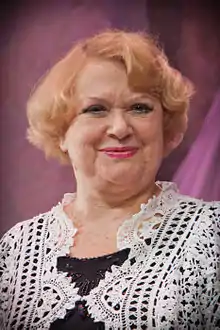Valentina Talyzina
Valentina Illarionovna Talyzina (Russian: Валентина Илларионовна Талызина; born January 22, 1935) is a Soviet and Russian film and stage actress, People's Artist of the RSFSR (1985).[1][2] Awarded the Order of Honor (2005) [3] and the Order of Friendship (2010).[4] Member of the Communist Party of the Soviet Union in 1964.
Valentina Talyzina | |
|---|---|
 Valentina Talyzina in 2012 | |
| Born | Valentina Illarionovna Talyzina 22 January 1935 |
| Occupation | Actress |
| Years active | 1958–present |
Biography
Early life
Valentina Illarionovna Talyzina was born on January 22, 1935 in Omsk. Valentina's father was Illarion Grigorievich Talyzin and her mother was Anastasia Trifonovna Talyzina. When Valentina Talyzina was an infant, her family moved to Baranavichy.[2][5]
Career
Between 1952-1954 she studied at the Omsk Agricultural Institute.[1]
In 1954 Valentina Talyzina was admitted to the Russian Academy of Theatre Arts. She graduated from the Academy in 1958. In the same year she became part of the Mossovet Theatre troupe.[1]
In cinema Valentina debuted in 1963 in the role of Inna in the detective film The Man who Doubts. But the actress began to actively act in film only in the late 1960s. One of the first big successes Talyzina on the screen was the role of Nadya in the adventure film Road to Saturn.[6]
Valentina Talyzina acted in the film The Irony of Fate and also voiced the main character because Barbara Brylska, who played Nadia, had an obvious Polish accent.[1]
For her performance in the television series Lines of Fate, Valentina Talyzina received the Golden Eagle Award as Best Television Actress in 2004.[7]
In March 2014 Talyzina signed a letter in support of the 2014 Russian annexation of Crimea.[8] She was banned from entering Ukraine, along with many other Russian artists and entertainers.[9]
Family
- Father — Illarion Grigorievich Talyzin, from Russified Tatar.
- Mother — Anastasia Trifonovna Talyzina.
- Ex-husband — painter Leonid Nepomnyashchy.
- Daughter — Ksenia Khairova, also an actress, granddaughter Anastasia (1998).[10]
Selected filmography
Total over 138 movies.
- 1968 The Road to 'Saturn' (Путь в «Сатурн»)
- 1968 Zigzag of Success (Зигзаг удачи) as Alevtina Vasil'evna
- 1971 Grandads-Robbers (Старики-разбойники) as Fedyaev's secretary
- 1972 Big School-Break (Большая перемена) as school chemical teacher
- 1974 Unbelievable Adventures of Italians in Russia (Невероятные приключения итальянцев в России) as hostess in the hotel
- 1974 Agony (Агония) as Aglaia
- 1975 Afonya (Афоня) as Vostryakova
- 1975 The Irony of Fate (Ирония судьбы, или С лёгким паром!) as Nadya (voice) / Valya
- 1979 The Luncheon on the Grass (Завтрак на траве) as Anna Petrovna
- 1981 Say a Word for the Poor Hussar (О бедном гусаре замолвите слово…) as Anna Speshneva
- 1983 Crazy Day of Engineer Barkasov (Безумный день инженера Баркасова) as Kobylina
- 1984 TASS Is Authorized to Declare... (ТАСС уполномочен заявить...) as Pilar (voice)
- 1985 Guest from the Future (Гостья из будущего) as Mariya Pavlovna
- 1985 After the Rain, on Thursday (После дождичка в четверг) as Varvara
- 1989 Investigation Held by ZnaToKi (Следствие ведут ЗнаТоКи)
- 1991 Genius (Гений) as Lubov Smirnova
- 2000 Old Hags (Старые клячи) as cleaning woman
- 2003 Lines of Fate (Линии судьбы) as Rosa Sergeevna
- 2007 The Irony of Fate 2 (Ирония Судьбы. Продолжение) as Nadya (voice) / Valya
- 2009 Attack on Leningrad (Ленинград) as Valentina
References
- "Биография Валентины Талызиной". RIA Novosti.
- "Валентина Талызина, биография, новости, фото - узнай все!". uznayvse.
- "Указ Президента РФ". Archived from the original on 2015-07-24. Retrieved 2015-12-06.
- Указ Президента Российской Федерации от 14 июня 2010 года № 713 «О награждении государственными наградами Российской Федерации»
- Валентина Талызина на сайте Театра им. Моссовета
- Биография Валентины Талызиной
- "На "Мосфильме" вручены кинопремии "Золотой Орел"". newsru.
- Russian artists supported Putin's aggression against Ukraine (LIST), Glavkom (11 March 2014)
- SBU issues entry ban against 140 Russian artists, UNIAN (5 November 2016)
Ukraine’s State Security Service bans 140 Russian cultural figures from entering country, TASS news agency (5 November 2016) - Валентина Илларионовна Талызина — Кто есть кто в культуре